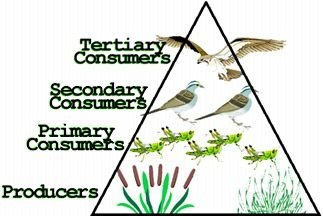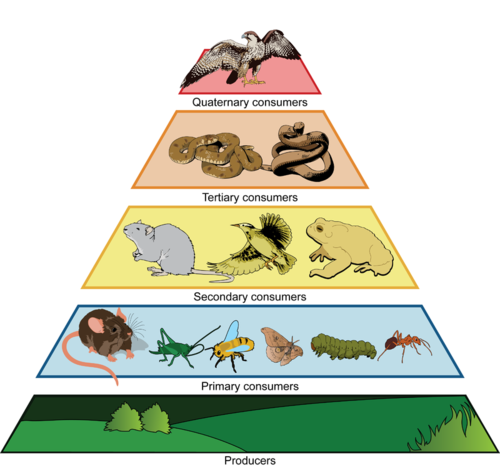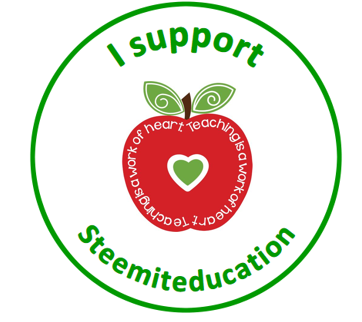Food webs
In nature there is a constant relationship between the animals that eat the plants and the animals that hunt and eat other animals. In order to have energy animals need to eat. The energy that is stored in the plant is carried over to the animal that eats it and that energy is again carried over to another animal that eats its prey.
This constant 'who eats who' is called a 'food chain' and a few food chains forms a 'food web.'
All living organisms need energy to get tasks done like running or jumping or learning and growing and the life processes to take place.
A plant produces its own food by using the sun, water and oxygen to photosynthesize and store the food in the form of starch. This starch contains energy and it is from here that the animal will get its energy when he eats the plant.
Energy does not get destroyed and is just carried over from the plant to the animal and then to another animal.
In short. The grass grows and produces food. The grasshopper eats the grass and the energy is now in the grasshopper. The snake eats the grasshopper and the energy is carried over to the snake. This is a simple food chain.
- Why do living organisms need energy?
- Explain in your own words what a food chain is.
- Draw a simple food chain.
- What is the name given to a few food chains that overlap one another?
The food chain consist of 'producers' and 'consumers'. Which living organisms produce their own food? That is right, plants. So plants are the producers in the food chain and the animals that 'consumes' (eat) the plants or other animals are called the 'consumers'.

Look at the sketch above - all green plants are producers. The animals that eat the plant is called the primary (first) consumer and then the next animal who eats the first one will be the secondary (second) consumer and right at the top of the pyramid will be the final animal that eats in that specific food chain and that will be the tertiary (third) consumer,
This pyramid can also be called an 'energy pyramid' because like we explained before the energy goes from the plant to the animals so it means it moves up in the pyramid. Each of these levels are called a 'trophic level'.
The number of steps an organism is from the start of the chain is a measure of its trophic level. Food chains start at trophic level 1 with primary producers such as plants, move to herbivores at level 2, predators at level 3 and typically finish with carnivores or apex predators at level 4 or 5.
- Study the energy pyramid below and discuss the different food chains/food webs that will form from this. In other words, 'who eats who' (Remember there are more than one option)

Animals can also be divided in 'predators' and 'prey'.
- Can you explain what is the difference between the two and give an example of each?
Both the predator and the prey have adapted in certain ways where they will blend in with their environment (this is called camouflage) or have ways to escape the predator. They also have different ways to hide.
- Watch the video to see the different ways in which animals have adapted as predators and prey to make sure they will survive
If a food web does not stay balanced, then it means the other animals in the food web will also suffer. Think about the lion that hunts the zebras. If all the zebras die and there is nothing else to eat, then the lions will also die. Or if the plants die then the animals that eat plant will not have food.
Humans cause a lot of destruction by killing animals or taking away their habitat (place where they live) and in this way we disturb the natural balance that must be between the living organisms.
It is important that we think before killing plants or animals, because every living organism has a function on earth, even if it is just to be food for another animal.
Enrichment
- Try and explain the following words in your own words - if you do not know the meaning, look it up
- herbivore
- carnivore
- omnivore
- environment
- habitat
- trophic levels
- energy
- food chain
- adaptation
- ecosystem
- Build your own 3 D model of the different trophic levels and the animals and plants you will find there and how they interact. Make sure to label your model. Use your imagination, but you can also have a look at the video for an idea. There is no specific way to do your model, you just have to make sure that the different animals are on the correct levels and you have named them all.

